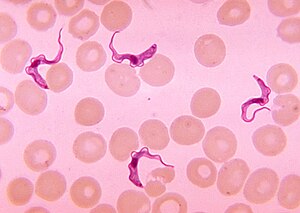Trypanosomatida
| Trypanosomatida | ||||||||||||
|---|---|---|---|---|---|---|---|---|---|---|---|---|

Trypanosomes in a blood smear from a patient with African trypanosomiasis |
||||||||||||
| Systematics | ||||||||||||
|
||||||||||||
| Scientific name | ||||||||||||
| Trypanosomatida | ||||||||||||
| Kent , 1880 |
The Trypanosomatida are a group of unicellular flagellates within the group of the Kinetoplastea , which are characterized by a single scourge and which all live as parasites . Many Trypanosomatida reproduce exclusively in insects ; some genera undergo a host switch between insects as a vector and a vertebrate host or a plant host .
The trypanosomatida include leishmanias and trypanosomes, important pathogens for leishmaniasis , Chagas disease and African trypanosomiasis in humans as well as for the animal diseases Nagana and Surra . Some plant pests of the genus Phytomonas also belong to the Trypanosomatida family.
features
All Trypanosomatida have a single flagella, which can be reduced to such an extent that it cannot be seen under the light microscope ( amastigote shape). A kinetoplast, a collection of mitochondrial DNA visible by staining, is also found in a single large mitochondrion . Many species show a change in shape in which the cell shape changes significantly in the course of the life cycle. This applies to both the cell size and the position of the flagella base ( trypomastigot , epimastigot , promastigot ) relative to the end of the cell.
Spread and hosts
Representatives of the Trypanosomatida can be found worldwide. All species live as parasites. Some genera only parasitize in one class of living beings, mostly insects; this includes the genera Blastocrithidia , Crithidia , Herpetomonas , Leptomonas and Rhynchoidomonas . The genus Phytomonas undergoes a host change between insects as a vector and plants, while Endotrypanum , Leishmania and Trypanosoma switch between insects (in aquatic trypanosomes also leeches ) and vertebrates .
Systematics
The first description of an order still under the name Trypanosomata, which was based on the type genus Trypanosoma , comes from the British marine biologist William Saville-Kent (1845-1908).
The Trypanosomatida belong with the Neobodonida , the Parabodonida and the Eubodonida to the Metakinetoplastina , a group within the Kinetoplastea defined on the basis of sequence comparisons of ribosomal RNA . In contrast to the other representatives, the Trypanosomatida are exclusively parasites with only a single scourge. Eleven genera are currently distinguished within the Trypanosomatida.
- Trypanosomatida Kent, 1880
- Genus Blastocrithidia Laird, 1959
- Genus Crithidia Leger, 1902
- Genus Endotrypanum Mesnil & Brimont, 1908
- Genus Herpetomonas Kent, 1880
- Genus Leishmania Ross, 1903
- Genus Leptomonas Kent, 1880
- Genus Phytomonas Donovan, 1909
- Genus Rhynchoidomonas Patton, 1910
- Genus Sauroleishmania Ranque, 1973
- Genus Trypanosoma Gruby, 1843
- Genus Wallaceina Podlipaev et al., 1990
While the Trypanosomatida itself and the genera Leishmania , Phytomonas and Trypanosoma are considered monophyletic , the other genera are probably paraphyletic . The reproduction exclusively in insects is considered original; the host change between insects and vertebrates probably occurred several times within the Trypanosomatida.
Web links
proof
- ^ William Saville Kent: A manual of the infusoria, including a description of all known flagellate, ciliate, and tentaculiferous protozoa, British and foreign and an account of the organization and affinities of the sponges. Volume I, David Bogue, London 1880, pp. 218-220. (on-line)
- ↑ D. Moreira, P. López-García, K. Vickerman: An updated view of kinetoplastid phylogeny using environmental sequences and a closer outgroup: proposal for a new classification of the class Kinetoplastea. In: Int J Syst Evol Microbiol. 54 (Pt 5), Sep 2004, pp. 1861-1875. PMID 15388756
- ↑ AG Simpson, JR Stevens, J. Lukes: The evolution and diversity of kinetoplastid flagellates. In: Trends Parasitol. 22 (4), Apr 2006, pp. 168-174. PMID 16504583